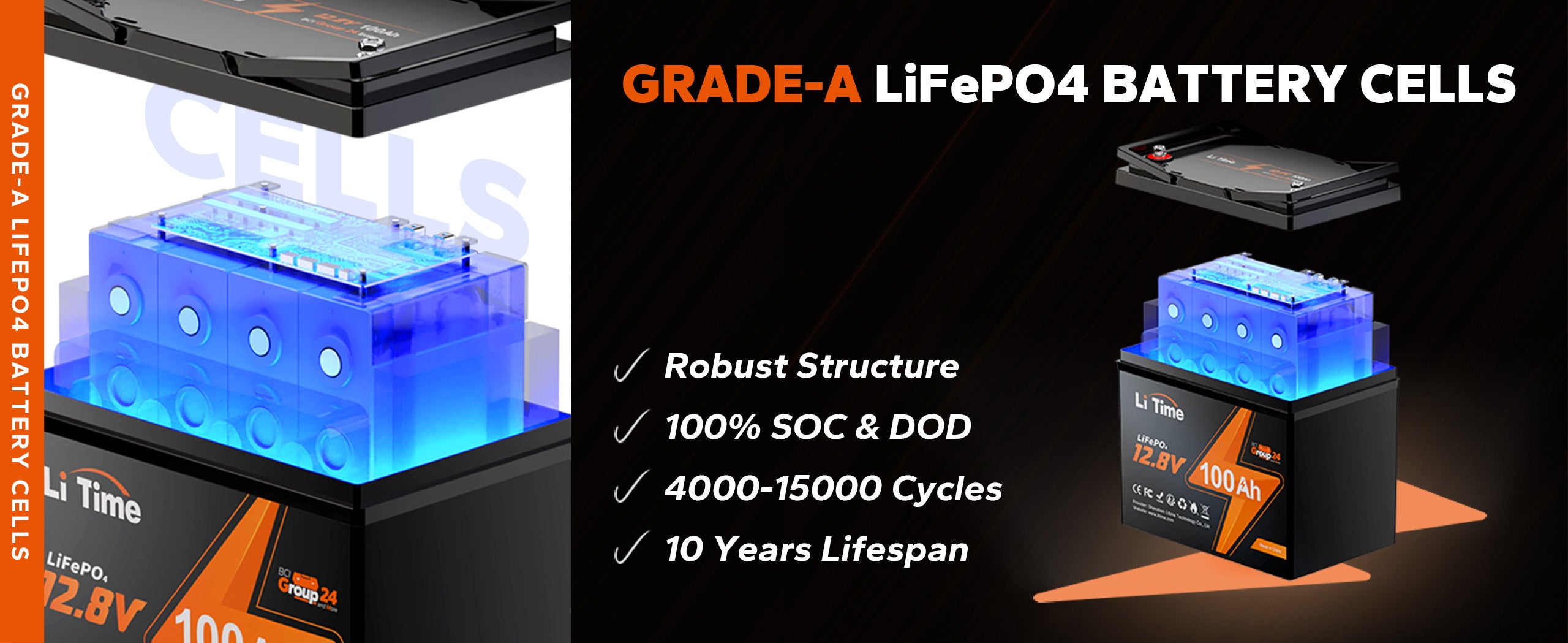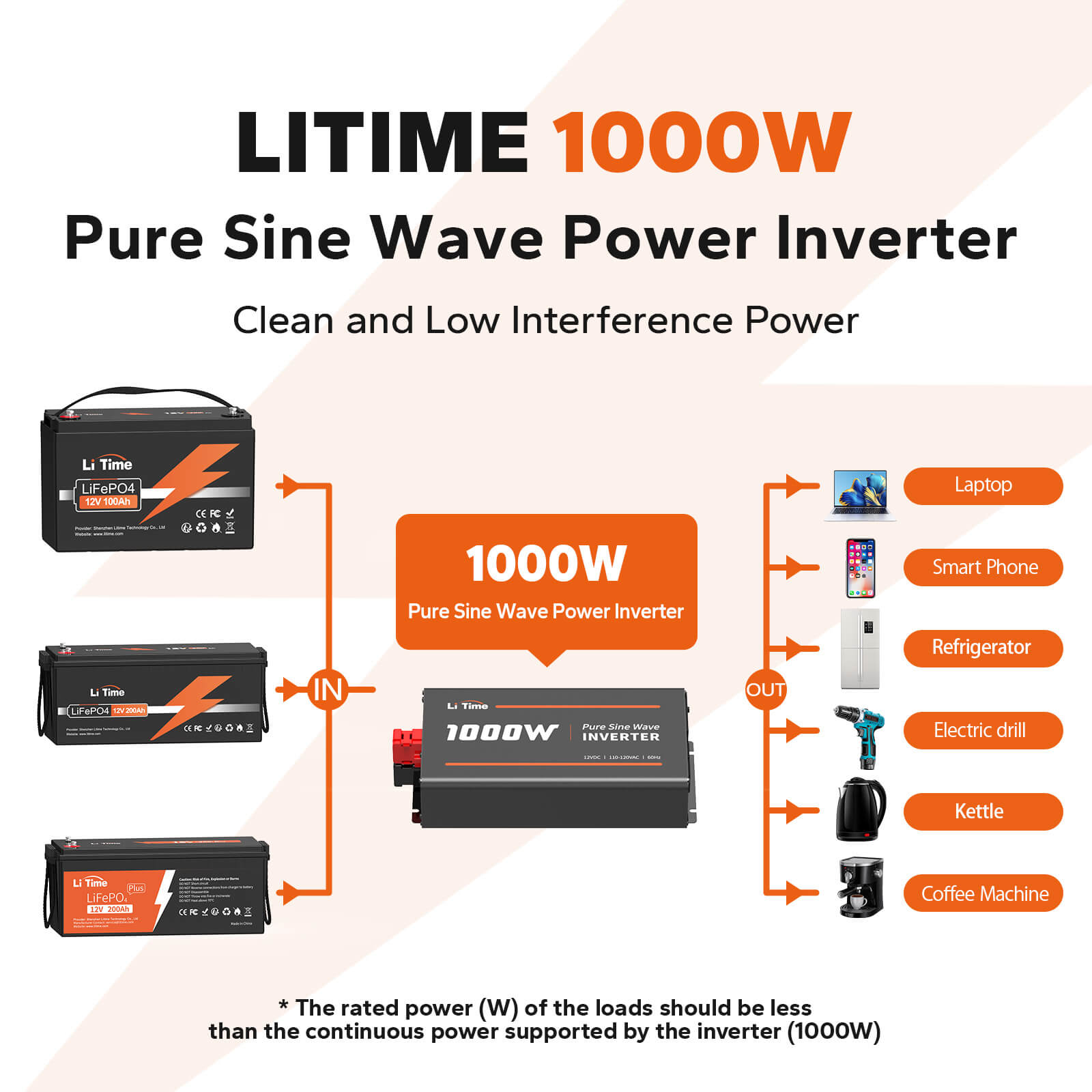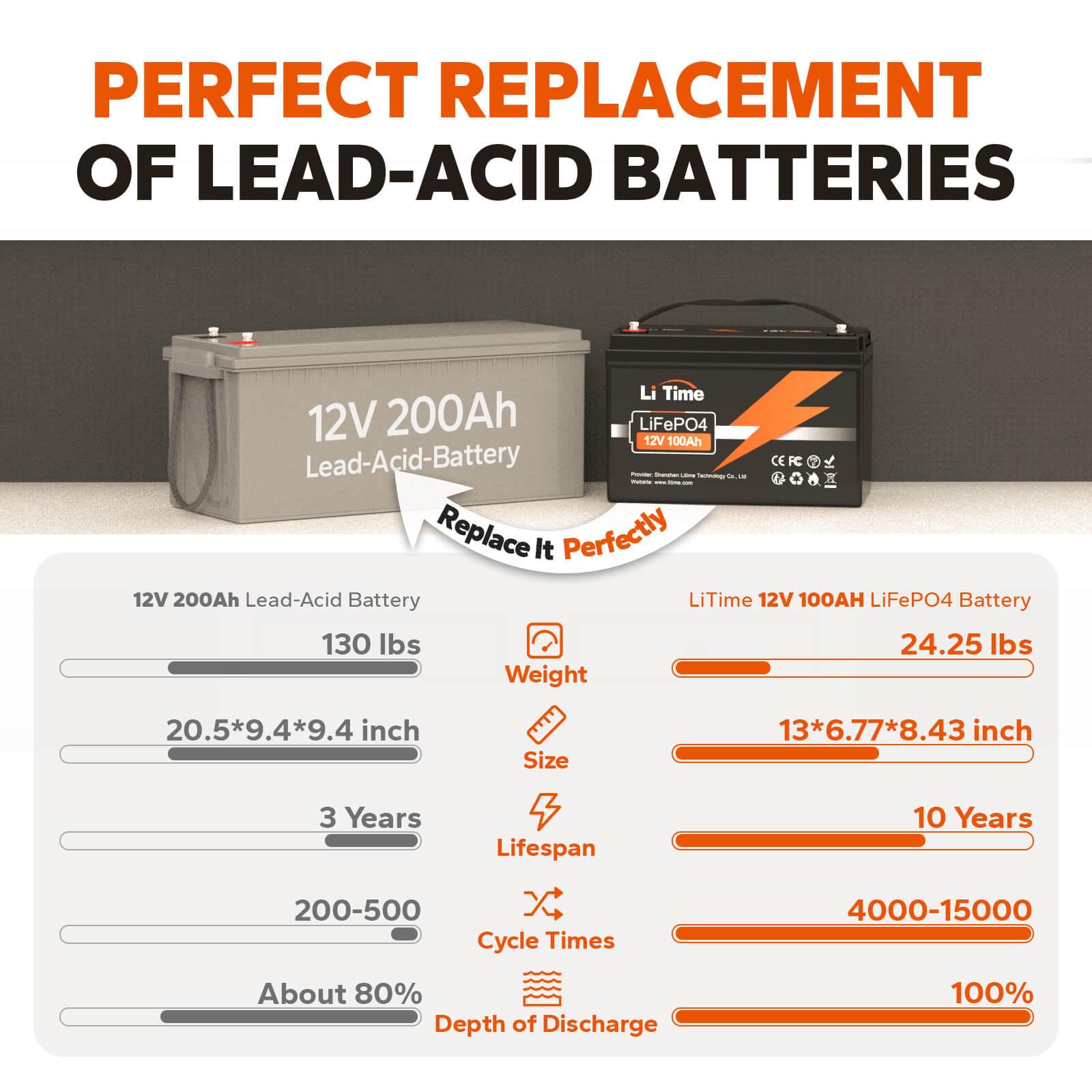When it comes to RV travel, adventurers are increasingly turning to sustainable energy solutions to power their journeys. One of the most popular and effective options is a complete RV solar system with batteries. In this comprehensive guide, we'll walk you through the essential components, benefits, and considerations for selecting the right system to power your RV adventures.
Table of Content
Part 1. Understanding RV Solar Systems
RV solar systems are composed of several key elements, each playing a crucial role in harnessing and utilizing solar power. These components typically include solar panels, a charge controller, a battery bank, a power inverter, and the necessary cables and wiring. Understanding these components is essential for designing an effective and efficient solar system for your RV.

Components of an RV solar system
1.Solar panels
Solar panels are the heart of an RV solar system. These panels are responsible for converting sunlight into electricity. They consist of photovoltaic cells that generate direct current (DC) when exposed to sunlight.
1.1 Types of Solar Panels Suitable for RVs
When considering solar panels for an RV, understanding the different types available is crucial for making an informed decision based on your specific needs. Here, we'll discuss the two primary distinctions: monocrystalline vs. polycrystalline panels and flexible vs. rigid panels.
1.1.1 Monocrystalline vs. Polycrystalline
(1). Monocrystalline Panels
- Efficiency: Monocrystalline panels are known for their high efficiency, making them capable of producing more power per square foot compared to polycrystalline panels. This efficiency makes them a popular choice for RV owners looking to maximize power generation within limited roof space.
- Durability: They are typically more durable and have a longer lifespan, making them well-suited for the rigors of RV travel.
- Space Efficiency: The sleek black hue and rounded edges of monocrystalline panels make them visually appealing, while their higher efficiency allows RV owners to achieve greater power output with fewer panels.
(2). Polycrystalline Panels
- Cost-Efficiency: Polycrystalline panels are generally more cost-effective than monocrystalline panels, making them an attractive option for those looking to stay within a budget while still harnessing solar power for their RV.
- Durability: While slightly less efficient than monocrystalline panels, polycrystalline panels still offer excellent durability and performance, making them a reliable choice for RV applications.
- Visual Appearance: These panels often have a bluish hue and square-cut edges, which might be a consideration for those concerned with the visual impact on their RV's roof.
1.1.2 Flexible vs. Rigid Panels
(1). Rigid Panels
- Traditional Design: Rigid panels are the standard, solid, and non-bendable solar panels most commonly seen on residential and commercial buildings.
- Installation: When considering rigid panels for an RV, they are typically installed on the roof and can be tilted or adjusted to maximize sun exposure. However, their weight and bulk may present challenges for certain RV models.
- Robustness: Rigid panels are known for their robustness and longevity, making them an enduring choice for RV solar applications.
(2). Flexible Panels
- Adaptability: Flexible panels are designed to be lightweight and bendable, allowing them to conform to the contours of a curved RV roof or other unconventional surfaces. This feature makes them particularly well-suited for RVs with limited mounting options.
- Weight and Portability: Their lightweight nature also makes flexible panels ideal for RVers looking to minimize added weight and maximize portability.
- Considerations: While flexible panels offer versatility, they may be slightly less efficient and have a slightly shorter lifespan compared to their rigid counterparts, thus requiring careful consideration based on the specific needs of the RV owner.
2. Charge controller
The charge controller regulates the flow of electricity from the solar panels to the battery bank. It prevents overcharging of the batteries by controlling the voltage and current coming from the solar panels. This helps protect the batteries and ensures they operate within safe parameters.
The types charge controllers are MPPT and PWM. Can read on MPPT VS PWM to learn more differences.
3. Battery Bank
The battery bank is where the electricity generated by the solar panels is stored. These can be different types of batteries, such as lithium-ion, lead-acid, or absorbed glass mat (AGM) batteries. The size and type of battery bank directly impact the amount of electrical energy that can be stored and used when the sun isn't shining.
4. Power inverter
The power inverter converts the direct current (DC) electricity produced by the solar panels and stored in the battery bank into alternating current (AC) electricity, which is what powers most of the appliances in an RV. This allows you to run devices that require AC power, such as laptops, TVs, and kitchen appliances.
5. Cables and wiring
Cables and wiring form the backbone of the entire system, connecting all the components together. These cables transport the electricity from the solar panels to the charge controller, then to the battery bank, and finally to the power inverter. Choosing the right size and type of cables is crucial to ensure that the system operates efficiently and safely.
These components work together to create a renewable energy system that allows RV owners to generate, store, and use electricity, providing an eco-friendly and cost-effective power solution for their travels.
Part 2. Importance of Batteries in an RV Solar System
At the core of any effective RV solar power system are its batteries, and this is where deep-cycle batteries play a vital role.
Deep-cycle batteries are purpose-built to offer a consistent current output over extended periods, making them the optimal choice for your RV solar setup. They serve as the energy hub for your solar configuration, storing the power gathered by your solar panels and disbursing it as needed.
Various kinds of deep-cycle batteries exist, each with its own advantages and considerations. The most prevalent types include AGM (Absorbed Glass Mat) batteries, Lithium-Iron Phosphate batteries (LiFePO4), and traditional Lead-Acid flooded batteries.
Selecting the appropriate battery for your RV is critical, as it significantly impacts the effectiveness and durability of your solar power system.
1. Flooded Lead Acid Batteries
Flooded Lead-acid batteries have a history spanning over a century and are frequently utilized in various applications, including RV solar systems. They operate via a chemical reaction between lead plates and sulfuric acid, generating electricity. As they discharge, the acid interacts with the lead plates, forming lead sulphate. When recharging, the process is reversed.
These batteries are favored for their cost-effectiveness and dependability. They represent a solid choice for many RV owners, particularly those on a budget or those who prefer a well-established solution. However, they do demand regular maintenance and generally have a shorter lifespan compared to AGM and lithium batteries. It's essential that they are stored outside the vehicle, not inside.
2. AGM Batteries
AGM batteries, a sub-type of lead-acid batteries, are a more contemporary and sophisticated alternative. They function through the same fundamental chemical process as lead-acid batteries but differ in having a fiberglass mat saturated with electrolyte instead of a freely flowing electrolyte solution. This design renders them spill-proof and nearly maintenance-free.
AGM batteries make an excellent choice for RV solar systems due to their impressive performance and longer lifespan compared to traditional lead-acid batteries. They are sealed and do not require topping up. Additionally, they handle high charge and discharge rates well and are less susceptible to damage from deep discharging. Although AGM batteries often come with a higher price tag, their advantages often outweigh the initial cost in the long term.
3. LiFePO4 Lithium Batteries
Lithium-iron phosphate deep cycle batteries, specifically Lithium-iron Phosphate (LiFePO4), represent the newest and most advanced option for RV solar systems. They function through a distinct chemical process involving lithium ions moving between positive and negative electrodes during charging and discharging.
These batteries are significantly lighter and more compact than both lead-acid and AGM batteries. They also boast a notably longer lifespan, can withstand deeper discharges without damage, and require no maintenance.
The primary drawback is their initial cost, usually higher than other options, and often necessitating the modernization of other electrical equipment within the RV to accommodate the lithium's charging profile. However, given their longevity, enhanced efficiency, and performance, they prove to be a much more cost-effective solution in the long run.
LiTime offers Grade-A cells and high-quality LiFePO4 lithium batteries at a cost-effective price, making them a compelling choice for those seeking the best performance and durability for their RV solar systems.

LiTime achieves this by leveraging their strong relationships with manufacturers and optimizing their supply chain. This allows them to source high-quality LiFePO4 cells at a competitive price, which they pass on to their customers. By prioritizing cost-effectiveness without compromising on quality, LiTime ensures that their LiFePO4 batteries are an excellent investment for users.
Part 3. Selecting the Right RV Solar System with Batteries:12V 24V Or 48V?
When selecting the right RV solar system voltage (12V, 24V, or 48V), it's crucial to consider several factors to determine the best option for your specific RV setup. Here's a breakdown of each voltage option and the considerations for selecting the most suitable one:
12V System
- Common for RVs: Many RVs are designed with 12V electrical systems. Choosing a 12V solar system simplifies integration with the existing RV electrical setup, making it a popular choice for RV owners.
- Component Compatibility: 12V systems are readily compatible with a wide range of RV appliances and accessories designed for 12V operation, which can make integration easier.
- Cost-Efficient: 12V components tend to be more cost-effective compared to higher voltage systems, both in terms of initial investment and maintenance.
24V System
- Power Efficiency: 24V systems are known for their improved power efficiency over 12V systems. They are capable of transmitting the same amount of power with smaller wire sizes, reducing voltage drop over longer cable runs.
- High-Power Requirements: If your RV has high power requirements or if you plan to expand your solar system significantly in the future, a 24V system may be more suitable.
48V System
- Commercial Applications: 48V systems are commonly used in larger off-grid or commercial setups due to their ability to accommodate very high power requirements efficiently.
- Efficiency and Flexibility: 48V systems are especially efficient at transferring power over longer distances and are often employed in large-scale or high-power solar installations.
- Space and Weight Considerations: While less common in most traditional RV setups, 48V systems could be beneficial if space and weight constraints allow for the additional components necessary to accommodate this higher voltage.
For more information, can read on What’s The Difference Among 12V VS 24V Vs 48V RV System?
RV Types And Battery Systems
Here's a breakdown of how different RV types can influence the choice of a solar system voltage:
1. Travel Trailers and Campers
These RVs typically come in a variety of sizes, from small trailers to larger fifth-wheel campers. When choosing a solar system for a travel trailer, consider the available roof space for mounting solar panels, as this can impact the overall capacity of the solar setup. The power requirements will largely depend on the appliances and electronics you intend to power while off-grid.
2. Motorhomes
Class A, B, and C motorhomes vary widely in size and amenities. Larger motorhomes with more onboard appliances and electronics may benefit from higher voltage systems (24V or 48V) to accommodate their higher power demands. Additionally, motorhomes often have more roof space available for solar panels due to their larger surface area, providing greater potential for solar power generation.
3. Pop-Up Trailers and Teardrop Trailers
Smaller camping trailers like pop-ups and teardrop trailers may have more limited roof space, so careful consideration of power requirements and available space is crucial when selecting a solar system voltage. In these cases, a 12V system may be sufficient and more practical given the limited overall power needs of these smaller trailers.
4. Truck Campers
Truck campers come in various sizes and configurations, and their solar system needs will depend on their size, amenities, and the power requirements of the appliances and electronics onboard. Evaluating the available space for solar panels and the overall energy needs is essential when choosing a solar system voltage.

When selecting the right RV solar system, it's important to match the system's voltage to the specific requirements and characteristics of your RV, including available roof space, power demands, and existing electrical setups. Additionally, understanding your usage patterns while camping off-grid can help determine the appropriate solar system capacity and voltage for your RV.
Before making a decision, it may be beneficial to consult with solar system professionals who can provide personalized recommendations based on your RV type, power requirements, and available space for solar equipment. This can help ensure that the chosen solar system meets your specific needs and integrates seamlessly with your RV setup.
Part 4. Installation and Maintenance Tips
When it comes to installing your RV solar system with batteries, precision and safety are paramount. If you're not experienced with electrical work, consider hiring a professional to ensure the system is installed correctly and safely. Proper installation not only ensures the system functions as intended but also minimizes the risk of damage to your RV or its electrical systems.
Maintenance of your RV solar system with batteries is relatively minimal, but it’s essential to monitor and upkeep the system to guarantee its longevity and consistent performance. Regularly inspect the solar panels for any dirt or debris that may affect their efficiency, and clean them as needed to maintain optimal energy production. Additionally, keeping an eye on the battery bank to ensure proper charging and discharging cycles, along with checking the connections for any signs of corrosion, is essential for maximizing the lifespan of your batteries.
Investing in a quality solar charge controller is also crucial for the longevity of the battery bank, as it helps regulate the flow of energy from the solar panels to the batteries, preventing overcharging or deep discharging. Regularly reviewing the system's performance and keeping an eye on any indications of potential issues, such as irregular power output, will enable you to address emerging problems early on and maintain the system's efficiency.
Part 5. Common Issues and Troubleshooting
While RV solar systems are generally reliable, it's important to be aware of potential issues that may arise and understand how to troubleshoot them effectively. Here are some common problems you might encounter with your RV solar system and the steps to troubleshoot these issues:
Reduced Power Output
If you notice a drop in power output from your solar panels, it could be due to dirt, debris, or shading. Troubleshoot this by cleaning the panels to remove any obstructions and ensuring that they are not shaded by nearby objects such as trees or buildings.
Battery Issues
Problems with your battery bank can manifest as insufficient power storage or irregular charging. Begin by checking the connections and ensuring they are secure. Verify that the charge controller is functioning properly and that the batteries are receiving the appropriate charge. If using lead-acid batteries, check for signs of sulfation, which can reduce their efficiency over time. For lithium-ion batteries, monitor for any signs of thermal runaway or pack imbalance.
Faulty Inverter Operation
If your inverter is not functioning correctly, check the input voltage from the solar panels and the output voltage to your RV's electrical system. Ensure that the inverter's connections are secure and that it is receiving the appropriate input power. It's also important to verify that the inverter switch is in the correct position.
Overheating Components
In hot climates, some components of your solar system might overheat, leading to reduced efficiency or potential damage. Ensure that the components are adequately ventilated and consider installing shading or cooling solutions to mitigate overheating issues.
Wiring and Connection Problems:
Loose or damaged wiring can lead to power loss or operational issues. Regularly inspect the wiring and connections to ensure they are secure and free from damage. Use a multimeter to check for voltage drops across connections and troubleshoot any inconsistencies.
Inadequate Charge Controller Operation
If the charge controller malfunctions, it can lead to overcharging or undercharging of the batteries, potentially shortening their lifespan. Verify that the charge controller settings are configured correctly for your specific battery type and capacity. If the controller is not working correctly, consider replacing it to avoid potential damage to the battery bank.
System Monitoring and Data Analysis
Implementing a monitoring system to keep track of energy production, battery status, and overall system performance is crucial. This enables you to quickly identify any irregularities and address them before they develop into significant issues.
Whenever you're troubleshooting issues with your RV solar system that are beyond your expertise or comfort level, consider seeking assistance from a professional with experience in solar power systems. Additionally, consulting the system's user manual and reaching out to the manufacturer or a certified installer for guidance can also be invaluable in resolving more complex issues. Regular maintenance and vigilance will ensure that your RV solar system with batteries continues to provide reliable power for your adventures.
Conclusion
In conclusion, a complete RV solar system with batteries offers an efficient, sustainable, and independent power solution for RV enthusiasts. By carefully considering the components, installation, and maintenance of such a system, travelers can unlock the benefits of solar power for their journeys. Whether you're a seasoned RVer or new to the lifestyle, this guide aims to equip you with the knowledge to make informed decisions when integrating solar power into your adventures.










